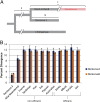Nuclear and mitochondrial DNA sequences from two Denisovan individuals
- PMID: 26630009
- PMCID: PMC4697428
- DOI: 10.1073/pnas.1519905112
Nuclear and mitochondrial DNA sequences from two Denisovan individuals
Abstract
Denisovans, a sister group of Neandertals, have been described on the basis of a nuclear genome sequence from a finger phalanx (Denisova 3) found in Denisova Cave in the Altai Mountains. The only other Denisovan specimen described to date is a molar (Denisova 4) found at the same site. This tooth carries a mtDNA sequence similar to that of Denisova 3. Here we present nuclear DNA sequences from Denisova 4 and a morphological description, as well as mitochondrial and nuclear DNA sequence data, from another molar (Denisova 8) found in Denisova Cave in 2010. This new molar is similar to Denisova 4 in being very large and lacking traits typical of Neandertals and modern humans. Nuclear DNA sequences from the two molars form a clade with Denisova 3. The mtDNA of Denisova 8 is more diverged and has accumulated fewer substitutions than the mtDNAs of the other two specimens, suggesting Denisovans were present in the region over an extended period. The nuclear DNA sequence diversity among the three Denisovans is comparable to that among six Neandertals, but lower than that among present-day humans.
Keywords: Denisovans; Neandertals; ancient DNA.
Conflict of interest statement
The authors declare no conflict of interest.
Figures



Comment in
-
Deciphering the Denisovans.Proc Natl Acad Sci U S A. 2015 Dec 22;112(51):15542-3. doi: 10.1073/pnas.1522477112. Epub 2015 Dec 14. Proc Natl Acad Sci U S A. 2015. PMID: 26668361 Free PMC article. No abstract available.
-
Why are there no persisting hybrids of humans with Denisovans, Neanderthals, or anyone else?Proc Natl Acad Sci U S A. 2016 Apr 26;113(17):E2354. doi: 10.1073/pnas.1602270113. Epub 2016 Apr 1. Proc Natl Acad Sci U S A. 2016. PMID: 27044111 Free PMC article. No abstract available.
References
Publication types
MeSH terms
Substances
Associated data
- Actions
LinkOut - more resources
Full Text Sources
Other Literature Sources

